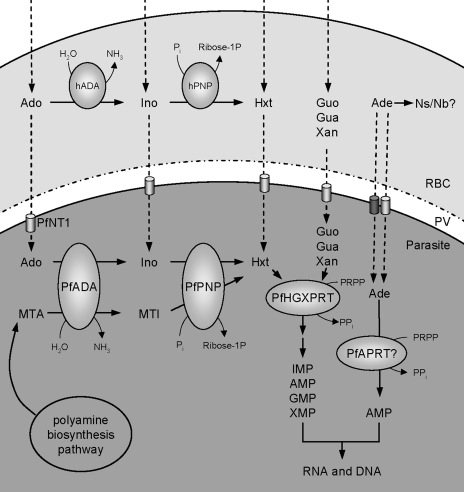FIG. 1.
Purine metabolism within the infected erythrocyte. Inosine is produced from adenosine by ADA. Inosine is then converted to hypoxanthine by PNP). hADA and hPNP are present in the red blood cell cytoplasm, while the parasite ADA (PfADA) and PNP (PfPNP) are active in the parasite cytosol. Both PfADA and PfPNP are capable of acting on 5′-substituted compounds, and so the parasite is able to salvage purines from the polyamine biosynthesis pathway (58, 60). Ado, Ino, Hxt, Guo, Gua, Xan, and Ade are transported across the parasite plasma membrane by PfNT1. Adenine also enters the cell via a second, PfNT1-independent mechanism. Adenine may be metabolized to other nucleosides/nucleobases (Ns/Nb) in the erythrocyte cytoplasm. PRT activity converts hypoxanthine to IMP, guanine to GMP, and xanthine to XMP. IMP, GMP, and XMP are then converted to guanylate and adenylate nucleotides by the action of several more enzymes, outlined in the text and in Fig. 2. There is some evidence to suggest that the parasite can also convert adenine to AMP by using a parasite-encoded APRT (PfAPRT). Abbreviations: Ado, adenosine; Ino, inosine; Hxt, hypoxanthine; Guo, guanosine; Gua, guanine; Xan, xanthine; Ade, adenine; PRPP, phosphoribosylpyrophosphate; RBC, red blood cell; PV, parasitophorous vacuole; MTA, methylthioadenosine; MTI, methylthioinosine.

